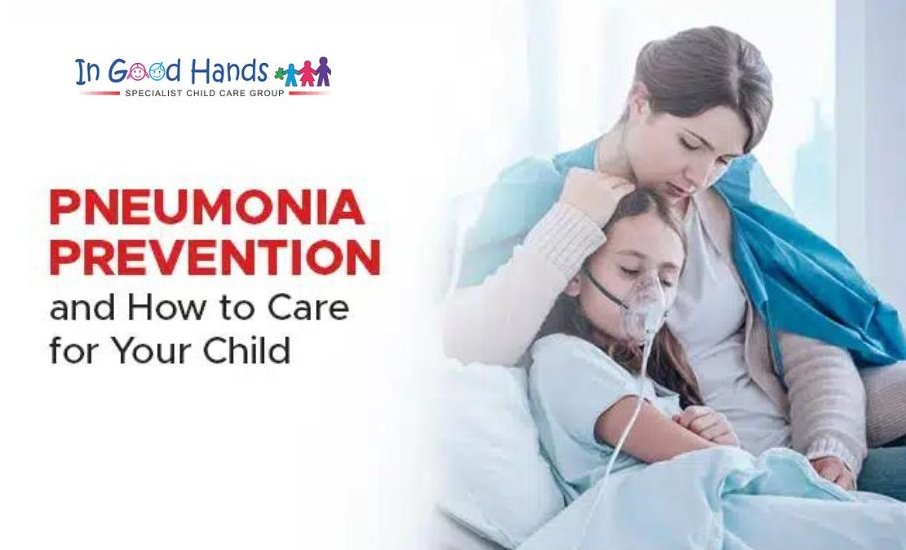Understanding Pneumonia in Children
Understanding Pneumonia in Children: Insights from Dr. Vivek Goswami, Noida Pediatrician
Symptoms of Pneumonia in Kids
Cough
A persistent cough that produces phlegm or mucus.
Fever
High fever, often accompanied by chills and sweating.
Difficulty Breathing
Rapid, shallow breathing and shortness of breath.
Chest Pain
Pain in the chest, especially when coughing or breathing deeply.
Vomiting or Diarrhea
Gastrointestinal symptoms are more common in viral pneumonia.
Bluish Lips or Nails
A sign of oxygen deprivation, indicating severe pneumonia.
Wheezing
A whistling sound when breathing, often seen in viral pneumonia.
Causes of Pneumonia
Pneumonia can be caused by various pathogens, with bacterial and viral infections being the most common in children. Fungal infections are rare but can occur in children with weakened immune systems.
Bacterial Pneumonia
- Streptococcus pneumoniae is the most common bacterial cause.
- Haemophilus influenzae type b (Hib) and Mycoplasma pneumoniae are also significant contributors.
Viral Pneumonia
Respiratory syncytial virus (RSV), influenza viruses, and adenoviruses are common viral agents.
Fungal Pneumonia
Fungal infections like Pneumocystis jirovecii are rare but can occur in immunocompromised children.
Diagnosis of Pneumonia
Dr. Goswami recommends several diagnostic tests to confirm pneumonia:
Physical Examination
Listening to the lungs for abnormal sounds such as sizzle or wheezing.
Chest X-ray
Visualizing the lungs to detect inflammation, fluid, or pus.
Blood Tests
Checking for elevated white blood cell counts indicating infection.
Sputum Test
Analyzing mucus coughed up from the lungs to identify the pathogen.
Bronchoscopy
In severe cases, a bronchoscope may be used to look directly at the airways.
Treatment of Pneumonia
Treatment varies based on the cause and severity of the pneumonia. Dr. Goswami outlines the following treatment protocols:
Antibiotics: Used for bacterial pneumonia. Common antibiotics include amoxicillin, azithromycin, and ceftriaxone.
Antiviral Medications: In cases of viral pneumonia, antiviral drugs may be prescribed.
Antifungal Medications: For fungal pneumonia, antifungal treatment is necessary.
Supportive Care: Includes hydration, rest, and fever management with acetaminophen or ibuprofen.
Hospitalization: Severe cases may require hospitalization for intravenous antibiotics, oxygen therapy, or other intensive care.

Preventive Measures for Pneumonia
Vaccination
Ensuring children receive vaccines such as the pneumococcal vaccine, Hib vaccine, influenza vaccine, and measles vaccine.
Avoiding Tobacco Smoke
Keeping children away from secondhand smoke, which can damage their lungs and increase susceptibility to infections.
Healthy Diet
Providing a balanced diet rich in fruits and vegetables to boost the immune system.
Breastfeeding
Encouraging breastfeeding in infants to provide essential antibodies and nutrients.
Sanitation and Cleanliness
Maintaining a clean living environment to reduce exposure to pathogens.
Frequently Asked Questions
Pneumonia in children can be caused by bacteria, viruses, or fungi. Common bacterial causes include Streptococcus pneumoniae and Haemophilus influenzae type b (Hib). Viral causes include respiratory syncytial virus (RSV) and influenza. Fungal pneumonia is rare and typically affects children with weakened immune systems.
Symptoms include a persistent cough producing phlegm or mucus, high fever with chills and sweating, difficulty breathing, chest pain, fatigue, loss of appetite, vomiting or diarrhea, bluish lips or nails, and wheezing.
Diagnosis involves a physical examination, chest X-ray, blood tests to check for infection, sputum test to identify the pathogen, pulse oximetry to measure blood oxygen levels, and in severe cases, bronchoscopy.
Treatment depends on the cause. Bacterial pneumonia is treated with antibiotics such as amoxicillin or azithromycin. Viral pneumonia may require antiviral medications. Supportive care includes hydration, rest, fever management, and in severe cases, hospitalization for intravenous antibiotics or oxygen therapy.
Preventive measures include vaccination (pneumococcal, Hib, influenza, and measles vaccines), regular handwashing, avoiding tobacco smoke, providing a healthy diet, encouraging breastfeeding, and maintaining a clean living environment.

